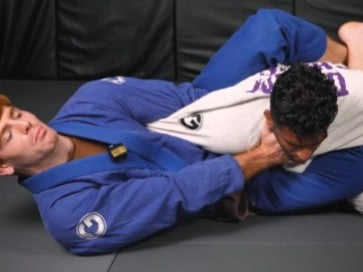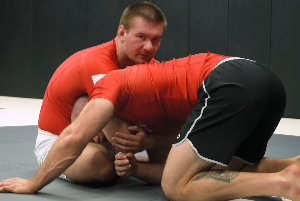Written by Alanna Kate Derrick, certified Personal Trainer and Sports Nutrition Coach.
Published on February 2nd, 2023
All sports come with the risk of injury, and martial arts, including Brazilian Jiu Jitsu, are no different. Fortunately, there are steps you can take to minimize your chances of getting hurt while training. Because there is no striking involved in Jiu Jitsu, it does tend to have a lower injury rate than some other martial arts, but it is still important to take the proper precautions to keep yourself safe as you develop your skills. While injuries may still happen occasionally, the following tips can help you stay as injury-free as possible so that you can keep training.
Work with Qualified Professors and Coaches
In an age when many people try to learn new skills through watching videos online, the importance of training with a skilled Jiu Jitsu professor or coach cannot be understated. When training at a Jiu Jitsu academy, the head instructor, or professor, must hold a black belt, representing years of training and dedication to the sport. Any instructor with a brown belt or below will be called a coach, though they will still have many years of experience and education in proper technique.
Whether your class is being led by a professor or coach, you can rest assured that they will have the experience needed to help you perform various grips, guards, chokes, and passes correctly and safely so you can avoid injuring yourself or others.
Pay close attention to your instructor's tips, and be sure to practice each move repeatedly to ensure you understand the correct form before attempting moves during a practice roll or competition.
Don't be shy about asking questions to help you improve your execution of each move.
Wear Proper-Fitting Jiu Jitsu Clothing
When first starting out in Brazilian Jiu Jitsu, you might wear typical workout clothes or borrow a gi from your academy, but as you progress, it is important to have the correct clothing for the sport. Having your own gear will ensure that everything fits you properly for maximum comfort and ease of movement. For no-gi classes, this meansgrappling spats,fight shorts, or both on bottom. On top, a tight-fittingrash guard with short or long sleeves will do the trick. In gi classes, you'll wear afull gi with aJiu Jitsu belt, with a rash guard under the gi jacket, though in IBJJF competitions, only women are allowed to wear a rash guard under the gi.
Learn How to Fall Safely
No matter how much Jiu Jitsu experience you have, you're undoubtedly going to hit the mat at some point, so you'll want to make sure that you know how to do it safely. This often means resisting the urge to break your fall with your arm or hand, as your opponent coming down on top of you could result in a broken finger or wrist or even a dislocated shoulder. Instead, roll into the fall, taking more of the impact on your hip, back, or shoulder, rolling to distribute the blow across a larger surface area.
Master Proper Gi Grips
Many Jiu Jitsu moves, such as the zipper choke, require you to get your thumb under the lapel of your opponent's gi. However, once you have a solid grip, it is important to release your thumb, maintaining your grip with your curled fingers. This will minimize your risk of breaking your thumb. The same holds true for gripping your opponent's sleeve or pant leg. While you may use your thumb to achieve the grip initially, you'll want to get it out of your closed fist as quickly as possible.
Avoid Overtraining
With any sport, Brazilian Jiu Jitsu included, there is a risk of overtraining. When you are excited about learning new moves and practicing your skills, you may want to attend classes or open mat sessions as often as possible. However, Jiu Jitsu can be hard on your body, and if you overdo it, especially in the early stages when you are building your fitness and endurance, you'll increase your risk of injury. Some common signs of overtraining include extended muscle soreness, difficulty sleeping, decreased performance, greater susceptibility to illness, and irritability. Be sure to listen to your body and incorporate rest days into your training schedule to allow your muscles to recover and rebuild so you can get stronger and continue performing at your best.
Prioritize Flexibility
Jiu Jitsu often puts your body in unusual positions, especially when you have your opponent's weight pressing down on top of you. Flexibility in your muscles and connective tissues is key to allowing your body to move as it needs to during a roll. When your muscles are overly tight, you won't have as wide of a range of motion and may have to tap out to avoid pulling or tearing a muscle. When cross-training, incorporate plenty of stretching, particularly for your hips, hamstrings, inner thighs, chest, and upper back. Greater flexibility will give you more options during a roll for getting your hooks in or controlling your opponent in a closed guard position as well.
Know Your Limits
It is crucial that you understand and respect your body's abilities and limitations. When practicing and training in Jiu Jitsu, there is no shame in tapping out when you need to. Attempting to push past your limits just to try to win a roll is a sure way to injure yourself. You won't be able to keep training if you are hurt, so back off when needed to keep yourself healthy and safe. This way, you can keep practicing to continue improving your skills.
Avoid Injuring Others
Of course, you want to keep yourself safe from injury when practicing Jiu Jitsu, but it is important to keep your opponent's safety in mind as well. One of the primary tenets of Jiu Jitsu is that it is about getting your opponent to submit, effectively stopping fights before anyone gets hurt. When grappling, always immediately respect the tap out, releasing your opponent as soon as they give the signal. As you train, focus on developing your technique, and stick with moves you know you can perform correctly during a roll. Attempting moves that you haven't yet mastered could put both you and your sparring partner at risk.



